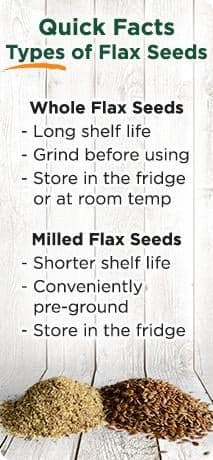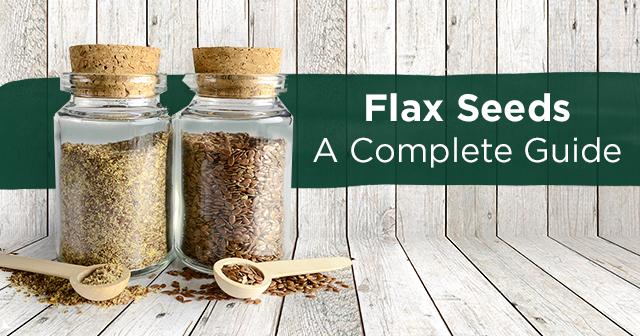Flax Seed Overview
Sometimes the tiniest foods pack the biggest punch. This is certainly the case with flax seeds, which are one of nature’s best-kept secrets. They may be small in size, but their nutrient profile is surely impressive. Fiber, protein and antioxidants are just the beginning!
Flax seeds are favored among those who follow a vegetarian or vegan diet because they’re a great way to get EFA nutrition. They contain ALA, a type of omega-3 fat that’s different than fish oil, which contains EPA and DHA. They’re also gluten free!
It’s important to note that flax seeds need to be ground to release the nutrients. The fibrous outer shell needs to be broken before consuming so our bodies can better absorb the goodness inside.
They have a subtle, nutty flavor that makes them a great addition to just about any food. When ground, flax seeds have a texture similar to coarse flour or wheat bran.
Flax Seed Health Benefits

Digestive support: Fiber & ALA support the digestive tract & GI health.
Healthy skin & hair: Essential fats & B vitamins help retain moisture.
Weight control: Healthier fats & fiber help you feel full longer, leading to consuming fewer calories.
Cholesterol support: Soluble fiber supports healthy cholesterol levels already in the normal range.
Hormonal balance: High levels of lignans & antioxidant properties.
Whole vs Milled? Which Type of Flax Seed is Right for You?
 Flax seeds are available in both whole and milled form, and there are pros and cons to each.
Flax seeds are available in both whole and milled form, and there are pros and cons to each.
Whole flax seeds need to be ground in order for our bodies to access the nutrients. Once they’re ground, they lose freshness in a few weeks. Having whole flax seeds on hand and grinding them as you need them (see below for instructions) is the best way to guarantee your body is getting the freshest product with the most nutrients.
Milled flax seeds are pre-ground, making them perfect for quick, convenient nutrition.
How to Grind Flax Seeds
 Even though flax seeds have a hard shell, they’re surprisingly easy to grind. They can be ground as finely as you prefer. Here are a few devices and ways to grind flax seeds:
Even though flax seeds have a hard shell, they’re surprisingly easy to grind. They can be ground as finely as you prefer. Here are a few devices and ways to grind flax seeds:
- Flax mill—perfect for those who don’t want to get flax remnants stuck in other devices
- Coffee grinder—conveniently choose how finely ground you’d like the flax seeds
- Pepper mill—makes it easy to sprinkle right onto your food
- Mortar and pestle—old fashioned and best for small quantities
- Food processor—best for doing large batches at once
- Immersion blender—least effective, but works in a pinch
How to Store Flax Seeds

Whole flax seed can be stored at room temperature in a sealed bag or container. Keep it in the fridge or freezer for an even longer shelf life. Before opened, whole flax seeds can be stored for up to a year. After opening, they’ll last for up to six months.
Ground flax seed should be stored in the fridge in a sealed bag or container. It’s best within 45 days after opening.
How to Add Flax Seed to Your Diet
Flax seeds are easy to add to just about any meal! With a subtle flavor, they can be sprinkled on just about anything. Here are a few easy ways to incorporate flax into your diet:
- Add to smoothies
- Blend with juice
- Sprinkle on hot or cold cereal
- Add to yogurt or ice cream
- Incorporate into your favorite pastries like muffins, pancakes or bread (try a little at a time to see how the addition affects the recipe)
Recipes that Use Flax Seeds
- 5 Ingredient Peanut Butter Energy Bites
- Flaxseed Pizza Crust
- Simple Morning Glory Muffins
- Banana Almond Flax Smoothie
- Blueberry Flax Pancakes
Sources
- http://www.bonappetit.com/test-kitchen/ingredients/article/how-to-eat-flaxseed
- http://draxe.com/10-flax-seed-benefits-nutrition-facts/
- http://www.newhealthadvisor.com/How-to-Grind-Flax-Seed.html
How do you use flax seeds? What are your usage or storing tips?





